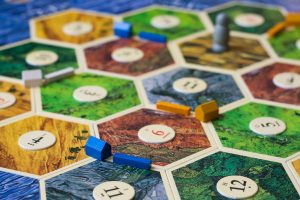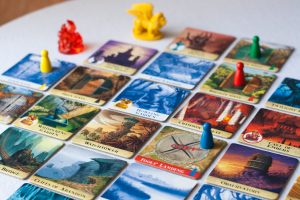Cross-posted from my dad blog…
My friend Sondra forwarded me a recent Atlantic article on the rising popularity of board games in the US. If you’ve been following this blog (or my Twitter or Instagram feeds), you know I’m a fan. I remember playing Settlers of Catan back in college, using a German edition my friend Chad had somehow obtained since there wasn’t an English edition yet. For me, and for many others, Settlers showed that a board game can be an engaging mix of strategy, luck, and social elements.
Back in the 90s, it seemed like only the computer science majors (like me) knew about such games. These days, I see snapshots of Settlers and Ticket to Ride and other German-style board games show up all over social media. I think these games occupy an interesting middle ground between luck-based games like Monopoly and Sorry and intense strategy games that take hours to play like Axis & Allies. I’m happy to see so many people discovering this middle ground — and the fun of sitting around a table playing an engaging game with friends. I’ve been hosting monthly (-ish) game nights at my house for a year now, and they’re always lots of fun.
As I’ve mentioned here on the blog, my girls like to play board games, too. We play a few traditional US games (Stratego, Connect Four, and Sorry are favorites), but more often family game nights feature newer games. Both girls have good minds for strategy, and they can both get fairly competitive. (Their mom is from New Jersey, what can I say?) Neither likes to lose, and sometimes Lily (the six-year-old) doesn’t handle losing all that well. Cognitively, Lily can handle games rated for ages 10 and up, but she has the emotional maturity of, well, a six-year-old. Losing something as low-stakes as a board game is good practice for her, however. It prepares her to keep her cool when faced with adversity at school, for instance. That said, the girls win a lot!
Recently, a friend asked me for recommendations for family games, and with Christmas coming up, I thought I would share a few here on the blog. Below, I’ve listed several that we’ve found to be fun, but feel free to share more games in the comments. I’m not sure what games I’ll get for the family this Christmas, but I’m sure I’ll pick up one or two!
Games for Younger Players

Sleeping Queens (Gamewright) – Thanks to my friend Brandy (married to the aforementioned Chad) for sharing this game with me. I was looking for a game that included some arithmetic, but was more interesting than Monopoly. Sleeping Queens starts with a dozen whimsical queen cards (Rose Queen, Moon Queen, Pancake Queen, and so on) face down. The goal is to play king cards (Tie-Dye King, Hat King, Puzzle King, and so on) to wake those sleeping queens. Collect enough queens, and you win the game. The king cards are shuffled into a very large draw deck, along with other cards both useful (like knights you can use to steal another player’s queen) and not (number cards with values ranging from 1 to 10). You can always discard a less useful card on your turn to draw another card from the deck, hoping for a king. Here’s where the math comes in: If you can make an addition equation out of a few of your number cards (using, say, a 2, 3, and 5 to make 2 + 3 = 5), you can trade in all of those number cards for an equal number of replacements, increasing your odds of scoring a king.
Sleeping Queens is rated ages 8 and up, but that seems high to me. As soon as your child starts learning some basic math facts, she’ll be ready for the game. The game is a quick one, lasting maybe 10 minutes once you get the hang of it. And you can play with 2, 3, 4, or 5 players. It comes in a box about the size of a paperback book, so it’s very portable.
Gobblet Gobblers (Blue Orange Games) – This game is like tic-tac-toe, but way better. Each player gets six silly-looking pieces: two small, two medium, and two large. You place your pieces in a 3×3 grid, just like tic-tac-toe, but here’s the interesting part: The pieces nest. A medium piece can be placed on top of a small one, and a large one on a medium piece. On your turn, you can play a new piece or you can move one of your pieces already on the board. Since you can play one of your larger pieces on an opponent’s smaller piece and move these pieces later in the game, there’s a ton more strategy than traditional tic-tac-toe. Unlike tic-tac-toe, which you can’t really lose if you’re paying attention, Gobblet Gobblers is a little bit challenging for adults. I know I’ve lost a game or two to my kids while actually trying to win.
Gobblet Gobblers is rated ages 5 and up, and that seems about right. Younger kids probably wouldn’t figure out the strategy involved. Games go really fast, usually around five minutes. (For more tic-tac-toe fun, try Ultimate Tic-Tac-Toe, which just requires a pencil and paper.)
Games for Older Players

Settlers of Catan (Mayfair Games) – The German game of the year back in 1995, this is a “game of discovery, settlement, and trade.” Each player starts with a couple of settlements on map consisting of hexagons, each of which produces one of five kinds of resources. On each player’s turn, the dice are rolled to determine which hexes produce resources, and players collect, trade, and spend their resources to expand their territory. Settlers has a near-perfect mix of strategy, luck, and social. There are several different ways to win and the game board is different every time you play, so the game never gets old. It can be a little addicting, too. At Thanksgiving this past week, I introduced it to some extended family, and we ended up playing three back-to-back games!
Settlers is rated ages 10 and up, but I think it’s fine for 8- and 9-year-olds. Games take an hour or two, depending on how quickly players make strategy and trading decisions. As for number of players, the standard game handles 3 or 4 players, and there’s a 5-to-6-player extension available for bigger families. I’ve played Settlers as a two-player game, without the trading element, and it works, but it’s not nearly as much fun.
 Ticket to Ride (Days of Wonder) – The German game of the year in 2004, this game is less complicated than Settlers, but still lots of fun. The game board is a map of the United States and part of Canada, with major cities connected by railroad routes of various colors. Players draw and collect train cards to match those colors and claim routes, attempting to connect pairs of cities that are sometimes very close (just a couple of routes away) and sometimes across the continent. Without the trading of resources, there’s not as much player-to-player interaction in Ticket to Ride, although you’ll find yourself competing for choice routes from time to time. Near the end of the game, you find out how much of a risk-taker you are, given the choices players face around drawing additional routes that they might not be able to complete.
Ticket to Ride (Days of Wonder) – The German game of the year in 2004, this game is less complicated than Settlers, but still lots of fun. The game board is a map of the United States and part of Canada, with major cities connected by railroad routes of various colors. Players draw and collect train cards to match those colors and claim routes, attempting to connect pairs of cities that are sometimes very close (just a couple of routes away) and sometimes across the continent. Without the trading of resources, there’s not as much player-to-player interaction in Ticket to Ride, although you’ll find yourself competing for choice routes from time to time. Near the end of the game, you find out how much of a risk-taker you are, given the choices players face around drawing additional routes that they might not be able to complete.
Ticket to Ride is rated ages 8 and up, but I think a bright 7-year-old could handle it. There’s no reading involved, and kids learn a little geography when they play. It runs a bit shorter than Settlers, with most games lasting less than an hour. You can play the game with 2 to 5 players, although it’s more fun with at least 3.

Love Letter (Alderac Entertainment) – My friend Katie introduced me to Love Letter. Well, her husband, really. We didn’t have a lot of time to play, so he brought out this quick little game. The game consists of just 16 cards. Each card features a different member of the royal court (the King, the Prince, the Priest, a Guard, and so on), and each has a point value and special ability when played. The goal is to end up with the highest point value card in your hand when the draw deck is empty, but that rarely happens. More typically, you use the cards’ abilities to knock out other players. Love Letter is a game of deduction. If you can figure out what card is in your opponent’s hand, you can usually find a way to knock her out. There’s a bit of card-counting, too, which isn’t so hard with only 16 cards!
Love Letter is rated 10 and up, but, as with most of these manufacturer ratings, that seems high. Ages 8 and up is probably a better guideline. There’s a bit of reading involved, but with only 16 cards, it’s pretty easy to memorize what they all do. Each round of the game goes very quick, but you have to win a set number of rounds to win the game, so a full game takes closer to 20 or 25 minutes. You can play with 2, 3, or 4 players, but 3 players is really optimal. The version I bought comes in a pretty red velvet bag, which my daughters find very funny every time we play. There’s a boxed version, too, but it was on back-order when I went to get a copy so I opted for the velvet. Either way, it’s highly portable. I found my girls playing it in their bedroom one night well after bedtime; Hannah had sneaked it up with her!

Takenoko (Asmodee) – One of the best sources for information about new games I’ve found these days is Instagram. There’s something about playing a tabletop game with friends that calls for taking and sharing a photo. I follow a number of board gamers on Instagram and learn about all kinds of interesting games from their snapshots. That’s how I learned about Takenoko, a completely adorable strategy game featuring a panda, a gardener, and bamboo. Players earn points by completing various objectives, most of which involve growing and eating bamboo of different kinds. There’s only one gardener (who grows the bamboo) and one panda (who eats the bamboo), and players take turns controlling these little figures. This means there’s a lot of player-to-player interaction as the gardener and panda move around the shared game board.
Takenoko is rated ages 8 and up, which seems about right. The learning curve is a little steep on this one, but once you’ve played a couple of times, it all makes sense and goes pretty quickly. Games last close to an hour, and you can play with 2, 3, or 4 players. I haven’t tried the game with only 2 players, but I’m guessing it’s not as much fun.
Fluxx (Looney Labs) – I remember playing this with friends ten years ago, and I was happy to introduce it to my kids more recently. Fluxx is a bit like Uno if the rules changed every other turn. You start off with just two rules: draw one, play one. But some of the cards themselves are rules (like “draw three” or “play all”), so as you play, the rules of the game change. You also play cards called Keepers that feature assorted objects and ideas like time, cookies, dreams, or a toaster. Objective cards tell you how to win. Maybe you need time and money or milk and cookies. New objective cards get played all the time, so your target is always shifting. The game is a little crazy, but lots of fun. Given how fast the objectives and rules change, there’s no long-term strategy involved, which makes it a bit easier for younger players to join in.
Fluxx is rated ages 8 and up, and that seems about right. There’s a lot of reading involved, and if you have a rules combo like “draw four, play one,” you end up with tons of cards in your hand to sift through. It’s generally a quick game. Given its mechanics, you might have a winner after two minutes, you might still be playing after 15 minutes. You can play with between 2 and 6 players. I can’t speak to larger games, but it works well for 2 or 3 players.

Forbidden Island (Gamewright) – My last recommendation is also the only game on this list that’s a cooperative game. All players work together to explore a mysterious island, capture its treasures, and escape before the island floods. Each player has a special skill (the diver can travel through flooded areas, the engineer can “shore up” extra areas to prevent flooding, the pilot can travel anywhere on the island in a single movement), and players have to work together as a team to win. The flooding mechanic makes for some tense moments, and winning the game (especially at the harder difficulty levels) requires careful and collaborative strategic thinking. The fact that Forbidden Island is a cooperative game works really well for my family since it means we can’t have one daughter lose while the other wins. I wish I had been introduced to cooperative games when I was their age!
Forbidden Island is rated ages 10 and up, but 8 and up is probably more accurate. Since it’s a cooperative game, older players can help younger players with the strategy involved. The game takes 30 or 40 minutes, and you can play with 2, 3, or 4 players. There’s also a sequel of sorts to the game, Forbidden Desert, that I hear good things about, but I haven’t played it.
Where Can You Get These Games?
Some of them, like Settlers, are available at your typical Target. Others, like Forbidden Island, you can find at Barnes & Noble, which has a pretty good game selection these days. Some, like Love Letter, you’ll have to order online. I’ve included Amazon links above (full disclosure: those are Amazon Affiliate links, so I’ll get a little finder’s fee if you order through those links), but my favorite online game retailer is Funagain Games. Every order seems to come with a $5-off coupon for your next order, which keeps prices close to Amazon’s. And if you’re in the Nashville area, head for Phillips Toy Mart over in Belle Meade. They have the best selection of games for all ages that I’ve seen locally.
Okay, your turn. What games does your family like to play?
